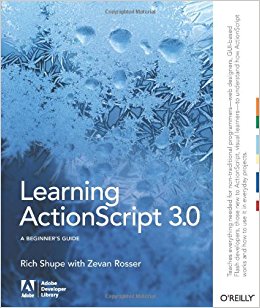Chapter 1: Introduction to ActionScript
Chapter 1: Introduction to ActionScript
3.0

https://www.amazon.co.uk/Learning-ActionScript-3-0-Beginners-Guide/dp/059652787X
About ActionScript
ActionScript is the programming language for the Adobe® Flash® Player and Adobe® AIR™ run-time environments. It
enables interactivity, data handling, and much more in Flash, Flex, and AIR content and applications.
ActionScript executes in the ActionScript Virtual Machine (AVM), which is part of Flash Player and AIR. ActionScript
code is typically transformed into bytecode format by a compiler. (Bytecode is a type of programming language that’s
written and understood by computers.) Examples of compilers include the one built in to Adobe® Flash® Professional
and the one that is built in to Adobe® Flash® Builder™ and available in the Adobe® Flex™ SDK. The bytecode is embedded
in SWF files, which Flash Player and AIR execute.
ActionScript 3.0 offers a robust programming model that is familiar to developers with a basic knowledge of objectoriented programming. Some of the key features of ActionScript 3.0 that improve over previous ActionScript versions
include the following:
• A new ActionScript Virtual Machine, called AVM2, that uses a new bytecode instruction set and provides
significant performance improvements
• A more modern compiler code base that performs deeper optimizations than previous versions of the compiler
• An expanded and improved application programming interface (API), with low-level control of objects and a true
object-oriented model
• An XML API based on the ECMAScript for XML (E4X) specification (ECMA-357 edition 2). E4X is a language
extension to ECMAScript that adds XML as a native data type of the language.
• An event model based on the Document Object Model (DOM) Level 3 Events Specification